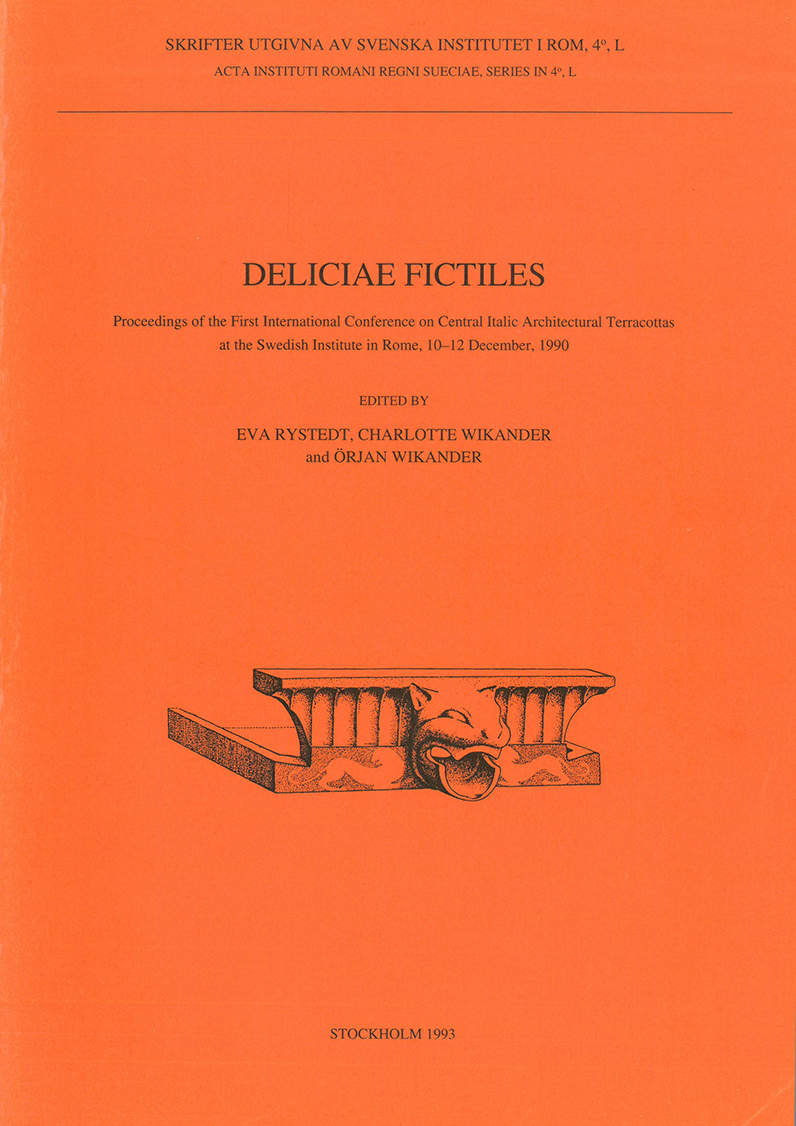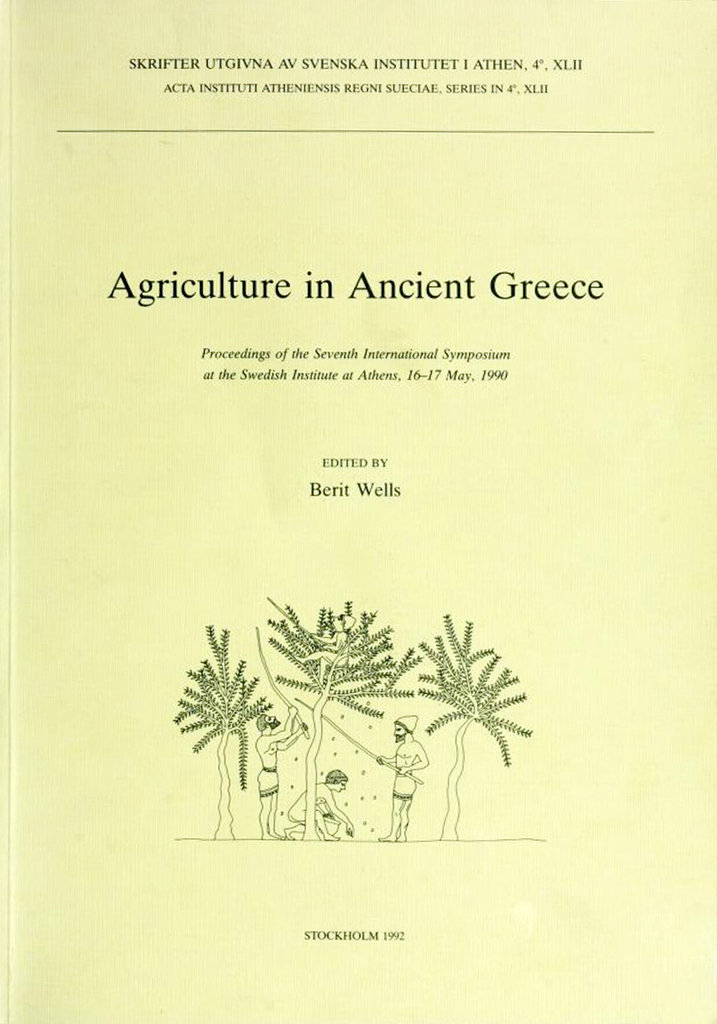Published by the Swedish Institute at Athens. Distributed by Astrom Editions. Ancient Greek hero cult. Proceedings of the Fifth International Seminar on Ancient Greek Cult, organized by the Department of Classical Archaeology and Ancient History, Göteborg University, 21–23 April 1995 Edited by Robin Hägg A collection of twelve papers, read at an international seminar in Göteborg, that deal with various phenomena of the ancient Greek hero cult, based on literary, iconographical and archaeological evidence. Among the special topics discussed are the hero cults in Early Iron Age Greece, the relationship between funerary ritual, the veneration of ancestors and the cult of heros, the Danaides of Argos as “ancestors”, the multilocality of heroes, patriotic heroes, the politics of the transferal of the bones of heros, the position of the Dioskouroi as Laconian heroes worshipped also in Attica, the origins of Greek hero cult in the context of overseas foundations, the heroon of Asclepius in Athens, the sacrificial rituals of Greek hero cults in Pausanias, the hero Melikertes-Palaimon at Isthmia, and the development of hero cults in the Hellenistic and Roman periods. Contents Preface (p. 7) Alexander Mazarakis Ainian | Reflections on hero cults in Early Iron Age Greece (pp. 9–36) Robin…
Published by the Swedish Institute of Classical Studies in Rome. Distributed by Astrom Editions. Cristina di Svezia e Roma. Atti del Simposio tenuto all’Istituto Svedese de Studi Classici a Roma, 5–6 ottobre 1995 Edited by Börje Magnusson Abstract Politics and culture in the age of Christina of Sweden (1626–1689) formed the subject of a conference in Stockholm in May 1995 (the acta published in Suecoromana, vol. 4). A second conference in Rome in September 1995 focused on the queen in her Roman ambience (1655–1689). One section of the present volume deals with her as patron of the arts, as well as collector, her interest here ranging from antiques to manuscripts. Several studies regard her role on the literary scene; a multitude of genres is presented, ranging from chronicle and panegyrics to musical drama. Although the majority of studies deal with literature and art, literature and science are also presented. Contents Premessa Kari Elisabeth Børresen | La religion de Christine de Suède M. Teresa Acquaro Graziois | Cristina di Svezia fra letteratura e cronaca Anna Vergelli | Cristina in panegirico, ovvero il Christinas Börje Magnusson | Drawing on Rome. Nicodemus Tessin, Christina and the creation of a royal ambience Concetta Ranieri…
Published by the Swedish Institute at Athens. Distributed by Astrom Editions Ancient Greek cult practice from the archaeological evidence. Proceedings of the Fourth International Seminar on Ancient Greek Cult, organized by the Swedish Institute at Athens, 22–24 October 1993 Edited by Robin Hägg A collection of thirteen papers, read at an international seminar in Athens, that deal with various phenomena of Greek cult practice, analyzing the information gained from the archaeological evidence. Among the special topics discussed are cult practice in the acropolis sanctuary of Minoa on Amorgos, the sanctuaries in the Artemision of Ephesos, the role played by osteological analysis in the understanding of Greek sacrificial practice, the interpretation of animal bones and fire traces connected with ritual feasting in the Herakleion on Thasos, ritual and society in Early Iron Age Corinthia, small dedications from the Archaic temple of Poseidon at Isthmia, altars in Greek hero cults, the early history of the sanctuary of Demeter and Kore at Eleusis, a sacrificial area near the sanctuary of Apollo Daphnephoros at Eretria, terracotta plaques and other finds from the sanctuary of Demeter and the Dioscouri at Messene, the interpretation of sickles in Greek sanctuaries, changes in votive practice from Classical to…
Published by the Swedish Institute at Athens. Distributed by Astrom Editions The function of the “Minoan villa”. Proceedings of the Eight International Symposium at the Swedish Institute at Athens, 6–8 June, 1992 Edited by Robin Hägg These twenty papers, presented at an international conference in Athens, deal with various aspects of the so-called villas in Neopalatial Crete and their possible predecessors or equivalents in the preceding, Protopalatial period. They are followed by transcripts of the discussions of the symposium. Among the problems treated are: the origin of the “villa system”, the definition of the “villa”, the architectural analysis of buildings and building complexes, the magico-religious background of the “villa”, the role of religious painting, the origin of the Cretan andreion, and a study of ceramic exchange between towns and outlying settlements in Neopalatial eastern Crete. Special discussions concern the functional analysis of the architecture, administration and bureaucracy, with special reference to seals, sealings and Linear A tablets and political geography. Contents ‘Preface’, 7 Henri van Effenterre & Micheline van Effenterre, ‘Towards a study of Neopalatial “villas”: modern words for Minoan things’, 9–13 Wolf-Dietrich Niemeier, ‘The origins of the Minoan “villa” system’, 15–19 J.A. MacGillivray, ‘The Cretan countryside in the Old…
Published by the Swedish Institute of Classical Studies in Rome. Distributed by Astrom Editions. Politics and culture in the age of Christina. Acta from a Conference held at the Wenner-Gren Center in Stockholm, May 4–6 , 1995 Edited by Marie-Louise Rodén Abstract Christina of Sweden (1626–1689) has been the object of both scholarly and popular interest in the three centuries that have passed since her death. This attention is related to the breadth of her influence on 17-th century European civilization. Thus, politics and culture in the age of Christina was the subject of a conference held in Stockholm in May 1995 and sponsored by the Wenner-Gren Center Foundation. The first section of the volume treats the relationship of politics and the arts in the age of absolutism as well as Christina’s political environment in Sweden and, from 1655, in Italy. Christina’s unfinished Autobiography is reexamined on the basis of previously unstudied manuscript variants and her religious profile is discussed. A second section treats Christina’s relationship to the arts. Christina’s role in Roman ceremonies and processions is examined. Contents Marie-Louise Rodén | Foreword Theodore K. Rabb | Politics and the arts in the age of Christina Jan Glete | Absolutism…
Published by the Swedish Institute at Athens. Distributed by Astrom Editions. See record at WorldCat: http://www.worldcat.org/oclc/849019970. The role of religion in the early Greek polis. Proceedings of the Third International Seminar on Ancient Greek Cult, organized by the Swedish Institute at Athens, 16–18 October 1992 Edited by Robin Hägg These twelve papers read at an international seminar in Athens deal with various aspects of the role of religion in the early Greek polis, based on the epigraphical, iconographical and archaeological evidence. Among the special topics discussed are territorial myths and the mythical articulations with regard to the early polis, the Greek temple-builders, the distribution of offerings and rituals between graves and sanctuaries, the development of sacred and profane civic ideology in Athens, processions (pompai), verbal and ritual obscenity in women’s cults, prohibitionary inscriptions, the role of the seer, the Thesmophorion in central Athens, the cults in Solonian Athens, cults by the seashore and Dionysos at Argos. Contents Preface (p. 7) Irad Malkin | The polis between myths of land and territory (pp. 9–19) Walter Burkert | Greek temple builders: who, where and why? (pp. 21–29) François de Polignac | Entre les dieux et les morts. Statut individual et rites collectifs…
Published by the Swedish Institute of Classical Studies in Rome. Distributed by Astrom Editions. Opus Mixtum. Essays in ancient art and society Edited by Eva Rystedt, Charlotte Scheffer, and Charlotte Wikander Fifteen papers on various aspects of ancient art and society are gathered in this volume. They deal with the choice of moment depicted in the Parthenon frieze, the use of the Greek architectural orders in political propaganda, and the “programme” of the relief plaques from zone F at Acquarossa which is suggested to be celebrations connected to the ruler. The architectural layout of a well-temple in Sardinia is interpreted as an iconographic message of the cult of Tanit-Astarte. The significance of the horse in connection with death and the various types of female deities connected with horses in Archaic Greek religion are discussed, as well as the image of Artemis Ephesia and its connection with the mysteries of the goddess, the epithet Ambologera (“Delayer of old age”) attributed to Aphrodite, and the role of women in Roman religion. A white-ground lekythos by the Achilles Painter with the “mistress-and-maid” motif associated with music-making is analysed. A reconstruction of the Laocoon group, especially regarding the positions of the serpents is put…
Published by the Swedish Institute at Athens. Distributed by Astrom Editions. Ancient Greek cult practice from the epigraphical evidence. Proceedings of the Second International Seminar on Ancient Greek Cult organized by the Swedish Institute at Athens, 22–24 November 1991 Edited by Robin Hägg. Bibliographical information Robin Hägg, ed., Ancient Greek cult practice from the epigraphical evidence. Proceedings of the Second International Seminar on Ancient Greek Cult organized by the Swedish Institute at Athens, 22–24 November 1991 (Skrifter utgivna av Svenska institutet i Athen-8°, 13), Stockholm 1994. ISSN 0081-9921. ISBN 978-91-7916-029-6.
Published by the Swedish Institute of Classical Studies in Rome. Distributed by Astrom Editions. Deliciae fictiles. Proceedings of the First International Conference on Central Italic Architectural Terracottas at the Swedish Institute in Rome, 10–12 December 1990 Edited by Eva Rystedt, Charlotte Wikander & Örjan Wikander Thirty-three papers on architectural terracottas read at an international conference in Rome. The papers include contributions on Greek material, but the main emphasis is placed on Central Italic roofs (from Northern Etruria to Campania) from the Archaic period. Several papers present hitherto unpublished material, either recently excavated or from earlier, unpublished, excavations and collections. Contents Eva Rystedt, ‘Preface’, p. 7 Arvid Andrén, ‘L’avviamento’, p. 9 ‘General list of abbreviations’, pp. 11–16 Nancy A. Winter, ‘The Greek background for Archaic architectural terracottas of Central Italy’, pp. 17–20 John F. Kenfield, ‘A modelled terracotta frieze from Archaic Morgantina: its East Greek and Central Italian affinities’, pp. 21–28 Concetta Ciurcina, ‘Rapporti tra le terrecotte architettoniche della Sicilia orientale e quelle dell’Italia centrale’, pp. 29–38 Elena Epifanio Vanni, ‘Antefisse di tipo campano a Himera’, pp. 39–43 Maria Bonghi Jovino, ‘La decorazione architettonica di Capua: peculiarità, itinerarii e modelli’, pp. 45–54 Ninina Cuomo di Caprio & Matilde Romito, ‘Fratti di…
Published by the Swedish Institute at Athens. Distributed by Astrom Editions. Agriculture in ancient Greece. Proceedings of the Seventh International Symposium at the Swedish Institute at Athens, 16–17 May 1990 Edited by Berit Wells These fourteen papers on ancient Greek agriculture were read, or emanated from the discussions during, an international conference in Athens; the papers are followed by transcripts of the discussions of the symposium. Two main themes are addressed: (1) production—how do we recognize a farm and what could be, and what was, produced on it? (2) and the organization of agriculture—who owned the land, who worked it and how, and how much did it yield? Contents Preface Jens Erik Skydsgaard | Agriculture in ancient Greece. On the nature of the sources and the problems of their interpretation (pp. 9–12) Eberhard Zangger | Prehistoric and historic soils in Greece: Assessing the natural resources for agriculture (pp. 13–18) Robin Osborne | ‘Is it a farm?’ The definition of agricultural sites and settlements in ancient Greece (pp. 21–25) Hans Lohmann | Agriculture and country life in Classical Attica (pp. 29–57) Discussion after first section on production Anaya Sarpaki | The Paleoethnobotanical approach. The Mediterranean triad or is it a quartet?…









